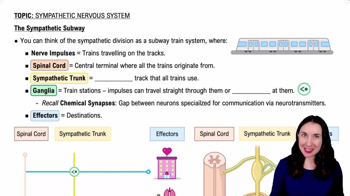Here are the essential concepts you must grasp in order to answer the question correctly.
Sympathetic Tone
Sympathetic tone refers to the level of activity of the sympathetic nervous system, which is responsible for the body's 'fight or flight' response. This tone increases heart rate, dilates airways, and mobilizes energy reserves, preparing the body for action in stressful situations. Understanding sympathetic tone is crucial for recognizing how the body reacts to stress and how it can impact overall health.
Recommended video:
Parasympathetic Tone
Parasympathetic tone is associated with the parasympathetic nervous system, which promotes the 'rest and digest' state. It helps to lower heart rate, enhance digestion, and conserve energy, facilitating recovery and relaxation. A balanced parasympathetic tone is essential for maintaining homeostasis and counteracting the effects of stress induced by sympathetic activation.
Recommended video:
Parasympathetic Nervous System Example 1
Balance Between Sympathetic and Parasympathetic Tone
The balance between sympathetic and parasympathetic tone is vital for optimal physiological function. An appropriate balance allows the body to respond effectively to stress while also recovering and maintaining health. Disruptions in this balance can lead to various health issues, including anxiety, cardiovascular problems, and digestive disorders, highlighting the importance of both tones in overall well-being.
Recommended video:
Review of the Sympathetic and Parasympathetic Divisions
 Verified step by step guidance
Verified step by step guidance


